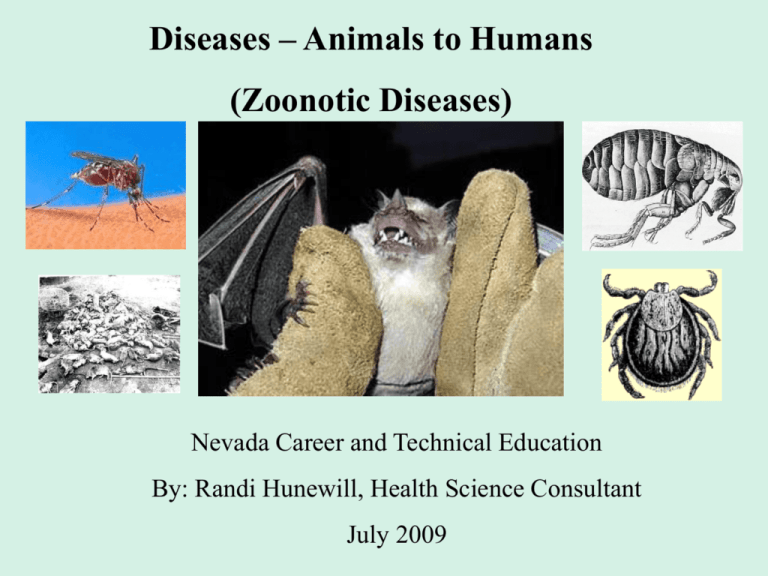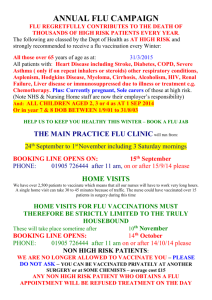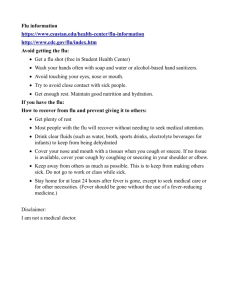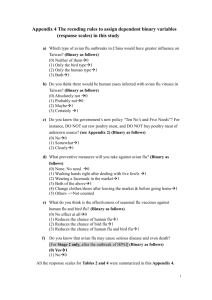Zoonotic Diseases
advertisement

Diseases – Animals to Humans (Zoonotic Diseases) Nevada Career and Technical Education By: Randi Hunewill, Health Science Consultant July 2009 What is a Zoonotic Disease? Zoonotic disease- a disease that can be passed from animals to humans Examples: Rabies Leishmania Tularemia Toxoplasmosis Cryptosporidiosis West Nile Virus Lyme Disease Brucellosis Q-fever BSE “Mad Cow” Anthrax Rocky Mtn. Spotted Fever Tapeworms Erlichiosis Encephalitis viruses Roundworms Listeriosis Chagas disease Hookworms Salmonella Ringworm Bird Flu Nipah virus Erysipelas Giardia Plague E. Coli Leptospirosis Histoplasmosis Campylobacter Rabies Virus Reservoir: Bat, Racoon, Cat, Dog Agent: Virus Transmission: Saliva of infected animals Human symptoms: Seizures, paralysis, fever Treatment: Supportive, most often fatal West Nile Virus Reservoir: Birds Agent: Virus Transmission: Mosquito bites bird, picks up virus, and then bites human Human symptoms: Fever, flu like symptoms Treatment: Supportive, usually clears in a few days in healthy individuals Toxoplasmosis Reservoir: Pigs, Cats, Rats, Deer, Lamb Agent: A single-celled parasite called Toxoplasma gondii Transmission: Touching infected cat feces, eating undercooked meat, contaminated water drinking Human symptoms: Flu like symptoms Treatment: Medications if needed, newborn babies infected through their mother can suffer eye and brain damage Bovine Spongiform Encephalopathy Also Known As: BSE or “Mad Cow Disease” Reservoir: Cattle Agent: Prion Transmission: Eating infected beef Human symptoms: Neurological disorders that worsen over time Treatment: Supportive, but usually fatal Lyme Disease Reservoir: Deer Agent: Borrelia burgdorferi, a bacterium Transmission: Black legged tick feeds on infected deer, picks up bacterium, and bites human Human symptoms: Rash, arthritis, fever, swollen lymph nodes, neurologic signs, heart problems Treatment: Antibiotics can be used for successful treatment when caught early Ringworm Reservoir: Any surface contaminated with fungus Agent: Several kinds of fungus Transmission: Touching a contaminated surface such as cat or dog hair, brushes or combs, cows, horses, and other animals Human symptoms: Rash shaped in a ring on the skin, scalp, groin area, and feet Treatment: Medicated creams, keeping area clean and dry H1N1 •Pandemic declared 6/11/09 •Nevada 406, no deaths •Virus, no vaccination •Antiviral Drugs, vaccine fall of 2009 •Swine flu parties Avian Influenza “Bird Flu” Click for: Discussion Questions Bird Flu Study Sheet Introduction to Bird Flu Important Points to Remember • There is no bird flu present in the U.S. today. • The U.S. does NOT import poultry products from other countries. • There is no danger of getting bird flu from eating chicken. You cannot get bird flu from properly cooked chicken. Cooking would kill any virus. • Keep all poultry products properly refrigerated and cook thoroughly before eating. Outline • Introduction to Bird Flu • What causes influenza? • Background on influenza pandemics • Impact of avian influenza on humans • Effects of avian influenza on agriculture and agribusiness • What should you do in a flu pandemic outbreak? • Summary Vocabulary Avian- Another word for birds Influenza- A contagious disease of the lungs, abbreviated as “flu.” Bird Flu- A flu virus carried by birds that can be transmitted to humans and other animals also known as Avian Influenza Domesticated Animals- Animals that live around humans Contagious- Capable of transmitting disease Pandemic- Infectious disease that affects people globally Zoonotic- Infectious disease that can be passed from animals to humans Introduction to Bird Flu • Bird flu is a lethal variant of the flu virus that poses a major threat to the world’s population. • The deadly flu pandemic of 1918 (the Spanish flu) was a strain related to bird flu. • Bird flu has reappeared in the past decade, and there is growing concern that another pandemic will occur in the near future. What causes avian influenza? • Avian influenza, also known as “bird flu,” is caused by a virus. • Virus is Latin for “poison.” • The flu is a contagious disease caused by a virus that normally only infects birds. What causes avian influenza? •Wild birds such as ducks and geese have been shown to be “silent carriers” of the virus. • Wild birds can spread the virus to domestic poultry flocks. • Bird flu is especially devastating to domestic poultry. • In the 1997 Hong Kong outbreak, every chicken was killed to prevent the spread to humans. What causes avian influenza? •Two forms of the virus can be found in birds. One form is mild while the other is extremely contagious and rapidly fatal. • A strain known as the H5N1 virus has caused widespread domestic poultry outbreaks since 2003. • The H5N1 is a zoonotic strain. It has the unique ability to cross the species barrier from birds to humans. Background on Influenza Pandemics • Influenza pandemics are rare, but have a high fatality rate. • Three flu pandemics have occurred in the past century: The Spanish flu of 1918, Asian flu of 1957, and the 1968 Hong Kong flu. • Death toll from the Spanish flu of 1918 was estimated to be 20-50 million worldwide. • Over half a million people died in the U.S. from the Spanish Flu. • More people died from the Spanish flu than were killed in World War I. Background on Influenza Pandemics • Research shows that the H5N1 virus could have pandemic potential. • The virus that infects birds has mutated into a strain that is contagious to humans. • If the virus adapts into a contagious strain capable of infecting humans, the H5N1 virus will no longer be a “bird flu.” It will be a “human flu.” Possible Impact of Avian Flu on Humans • There have only been a few cases in which the virus was transmitted from bird to human. • The symptoms range from typical flu-like symptoms, such as fever, cough, sore throat, and muscle aches to more serious health conditions. Possible Impact of Avian Flu on Humans • Pneumonia, severe respiratory disease, and eye infections have resulted from human infections of H5N1. • This virus has the ability to infect young and healthy people, unlike most flu viruses that primarily infect the elderly and young children. Possible Impact of Avian Flu on Humans Estimated impact of a future pandemic in the U.S. includes the following: • Deaths: 89,000-207,000 • Hospitalizations: 314,000- 734,000 • Economic impact: $71.3- 166.5 billion Source: www.cdc.gov Possible Effects of Avian Influenza on Agriculture and Agribusiness An Important Industry at Risk • Poultry is the #1 agricultural industry in Georgia. Bird Losses Could be Devastating • “Stamping Out” has been the preferred method of controlling outbreaks in birds. This method involves killing all of the poultry on the infected farm as well as on farms in the surrounding area. Possible Effects of Avian Influenza Shut Down •In an effort to quarantine the outbreak, schools might be closed, transportation shut down, and the economy could come to a virtual halt. • The transport of food could stop. The nation’s food supply would only last a matter of days. What Should You Do in a Possible Flu Pandemic Outbreak? CLEAR • Stay CLEAR of contact with infected people. Use a protective mask. Although not 100% protective, a mask can help trap some of the virus particles. WATCH • If you are around an infected person, take your temperature often. WATCH for flu-like symptoms. CALL • CALL your doctor to discuss treatment. Seek medical attention within 24 hours of symptoms. What Should You do to Prepare for an Outbreak? As of January 2006, there are no bird flu cases in America: 1) DO NOT panic. 2) DO keep eating. You cannot get flu from eating fully cooked chicken and duck. Avoid eating undercooked eggs or poultry. 3) DO get a flu vaccine. The vaccine will not be effective against bird flu, but it can protect you from circulating other flu viruses. Source: Newsweek, October 31, 2005 What Should You do to Prepare for an Outbreak? 4) DO NOT hoard drugs, such as Tamiflu. Patients will need all available medication if a pandemic hits. 5) DO avoid hot spots in Asia with known infections if you travel. 6) DO stay clean by washing your hands frequently. Use soap, water, and alcohol-based gels. Source: Newsweek, October 31, 2005 Key Points • A flu pandemic “may” occur in the near future. There is no bird flu currently in the US. • Bird Flu could be the next pandemic strain. • Governments are not prepared because of the virus strain variation. • An outbreak could have devastating economic consequences. • Agriculture, especially the poultry industry, could suffer devastating losses. End of Bird Flu Slides Click for: Discussion Questions, Bird Flu Study Sheet DISCUSSION QUESTIONS 1. What would happen if there were an epidemic so bad that it completely fills hospitals? Student Responses: Move patients to another hospital (Teacher Response: Would infect surrounding communities) Student Responses: Quarantine (Teacher Response: Would this be done on a local level or would the government have to step in?) 2. Has anyone ever had the flu? If so, describe what it was like? How sick were you? 3. What do you think the bird flu is? Sample: Student Responses: Something that makes birds sick (Teacher Response: Not all birds will become sick because they are carriers. However, many domestic birds that contract the virus are affected.) 4.How is this virus spread from animal to human? Sample: Student Responses: Eating infected chicken (Teacher Response: Being in direct contact with infected birds, particularly poultry.) 5. What would happen if the bird flu came through this area, and how would you and your family respond to the epidemic? Sample: Student Responses: Get a shot (Teacher Response: There is no vaccination for bird flu. Other flu strain vaccinations can be used but are not completely successful in controlling the virus. The bird flu virus is highly contagious and has the potential to kill millions. Antiviral drugs, such as Tamiflu, can be taken within 48 hours of contracting the virus.) What would you do if you had a family with small children knowing that there was no cure for Bird Flu? Sample: Student Responses: Stay away from the infected/lock themselves in their homes/stay away from birds (Teacher Response: This solution may seem to make sense, but how would you lock yourself away from the world and survive for long periods of time? How would you eat? Although birds are the main carriers, other household animals can become infected with the virus.) DISCUSSION QUESTIONS 6. How would the economy suffer if everyone locked themselves inside their homes? Student Responses: Everything would shut down (Teacher Response: All public services would shut down including banks and stores. Eventually the entire economy would shut down, and the food supply would become obsolete.) How long can we survive without food and water? Sample: Student Responses: I live on a farm so we could grow our food. (Teacher Response: You would still run out of items that you cannot grow. What would happen if it infected your farm animal population? It is said that you can survive up to 3 weeks without food but only 3 days without water.) How long would it take before we began to run out of food? Sample: Student Responses: Months (Teacher Response: It would only take a matter of hours after the initial scare for store shelves to be completely empty of the essential items. Think about the run on items during an ice storm.) 7. How would we as responsible citizens respond? Student Responses: Help the people that were sick (Teacher Response: The flu is spread through contact, and you would need to allow the medical professionals deal with those people. You would need to remain calm.) 8. How would Bird Flu affect the agriculture industry in this community? And within the state? And within the country? Student Responses: It could never happen to us (Teacher Response: Even though we have not seen a direct threat, it does not mean that it could not affect us. Some say the world is overdue for another large-scale outbreak.) 9. How would Bird Flu affect the agriculture industry in this community? And within the state? And within the country? (Teacher Response: Nationally, Georgia is number 1 in poultry production and marketing of other animals as well.) 10. What is being done to control Bird Flu virus? (Teacher Response: Even though there is not a vaccine for the virus, research is being done to protect us from a flu outbreak like the Spanish flu.) STUDY QUESTIONS 1. The deadly flu pandemic of ______was a strain related to the bird flu. A. 1978 B. 2000 C. 1956 D. 1918 2. Education and _________ about Bird Flu will be important in an outbreak to prevent infection and control panic? A. College B. Power C. Knowledge D. Strength 3. What strain is known to have caused large outbreaks in domestic poultry since 2003? A. ID10 B. H5N1 C. 3500 D. 1G45 4. What group of people does the rabies virus target? A. Old B. Young C. Healthy D. All 5. Influenza pandemics are rare, but highly________. A. Expected B. Noncontagious C. Fatal D. Survivable STUDY QUESTIONS 6. Bird Flu is especially devastating to the domestic________ industry. A. Poultry B. Sheep C. Beef D. Equine 7. What should you do in case of an outbreak of a contagious zoonotic disease? A. Remain Calm B. Run to the store C. Hide in your house D. Take aspirin 8. Which animals are ‘silent carriers’ of the rabies virus? A. Bats B. Turtles C. Quail and chicken D. Cattle and hogs 9. What causes the avian influenza virus to spread from animal to human? A. Weather B. Mutated Viruses C. Bacteria D. Blood Type O 10. More people died from the Spanish Flu of 1918 than were killed in World War I. A. True B. False 11. There is no known cure for rabies. A. True B. False 12. Most people that had the flu in 1918 are still living. A. True B. False 13. Because of earlier outbreaks our generation is immune to rabies. A. True B. False STUDY QUESTIONS _______ 14. Avian A. Capable of Passing Disease _______ 15. Pandemic B. Animals that live around humans _______ 16. Contagious C. A contagious disease in the lungs _______ 17. Zoonotic D. Another word for birds _______ 18. Bird Flu E. Infectious disease that affects people globally _______ 19.Influenza F. Disease that can be passed from animal to human _______ 20. Domesticated Animal G. A virus carried by birds that can be passed to humans Zoonotic Diseases Study Sheet Answers 1. 2. 3. 4. 5. 6. 7. 8. 9. 10. 11. 12. 13. 14. 15. 16. 17. 18. 19. 20. D C B D C A A A B A A B B D E A F G C B Sources • http://www.who.int/en/ • http://www.cdc.gov/ • http://department.caes.uga.edu/poultry/exte nsion/exeduprgs.htm • http://www.amerpoultryassn.com/ • http://www.avianinfluenzainfo.org/ • http://www.pandemicflu.gov/







